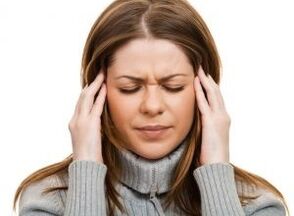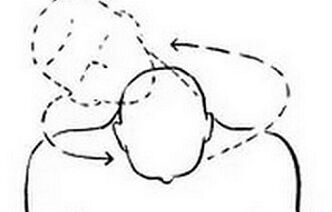
Osteochondrosis of the cervical spine is most often diagnosed in women and middle-aged men because the department is more susceptible to loading.The first sign of the disease is usually unexpressed, so it is difficult to identify the problem in the initial stages of development.
The manifestations of osteochondrosis are related to the impact of many factors on the human body.In order for the treatment to be adequate, osteochondral bone disease is important, and it is important to find out the root cause of the occurrence.
The main causes of disease
Cervical osteocartilage degeneration is a pathology of the nature of degenerative diseases, in which, under the influence of negative factors, the fabric of the cervical intervertebral disc.Over time, the disease affects other structures of the spine, resulting in a violation of its function.Unpleasant symptoms begin to bother the person and his health gradually deteriorates.
The main reason for vertebral degeneration is that it violates the body's metabolic function.The vertebrae and vertebrae structures do not receive the necessary beneficial substances and elements.Bone growth plants appear on bone tissue.Ossification spreads over time.Neglected osteochondrosis leads to the fact that the cervical spine is fixed due to the fusion of the vertebrae.
Developing the triggering mechanism of such processes is a negative factor that constantly affects the human body.
The reasons for bone-soft criminals are as follows:
- congenital pathology of musculoskeletal system structure;
- Genetic tendency;
- Focus on physical exercise;
- A sedentary lifestyle;
- Violation of posture;
- Back injury;
- scoliosis;
- stress, excessive damage to tension;
- Complications after severe infectious diseases.
Disease degree and manifestation
The initial stage of the disease is characterized by periodic headaches.
Signs of osteochondrosis in the cervical vertebrae gradually develop.As the pathology progresses, the symptoms become more obvious.
Distinguish the 4 stages of cartilage development:

- There are no obvious osteochondrosis symptoms to 1 degree.Sometimes, headaches can be disturbed and discomfort on the neck.The symptoms pass quickly after rest, but the degeneration process has begun in the disc, in which the integrity of the pulp pulposus is violated.
- When the second stage of pathology switches to the vertebrae cartilage is covered by a crack, the disk core is extinguished.The intervertebral space is reduced and the patient complains about acute pain in chronic shapes.
- In the third stage of progression, osteochondrosis in the cervical region is characterized by severe vertebrates and headaches.Due to hypoxia and brain cells suffer, a person may temporarily become paralyzed and have hearing and vision problems.In the cervical area, there are hernia that squeezes nerves, muscles, arteries and veins.
- When the last piece (4 tablespoons) of cervical osteochondral disease symptoms become so obvious that the patient cannot relax and rest even for a minute.Bone plants on the vertebrae form, and a person is disabled due to disturbance of the movement of the neck.If you do not start full treatment at this stage, the situation may lead to death.
Characteristic Symptoms
If you have started using vestibular devices, you need to pay attention to your health.
Osteochondrosis of 1-2 degrees is effectively conservatively treated.In late stages, it is difficult to fully restore the damaged vertebrae structure.This means that the disease is important for the initial stage diagnosis.Therefore, if a person has similar symptoms, he is urgently required to see a doctor:
- Acute pain and discomfort, located in the neck, shoulders, nape;
- Severe headaches and dizziness caused by cervical nerves and blood vessels;
- Violating visual and auditory functions;
- muscle weakness;
- Numbness, the feeling of chicken skin ump running along the skin;
- Functions of vestibular devices.
Cervical osteocartilage degeneration at the C4-C6 vertebrae level is characterized by violation of the sensitivity of the upper limbs, hands and fingers.If the vertebral artery is compressed, dangerous diseases occur in the brain will be worried.Due to the lack of blood supply and brain cell nutrition, hypoxia occurs.If you don't treat it in time, the patient will start to have memory problems, the swallowing function will be disturbed, and the squeeze in Kadyk's throat will be disturbed.
Usually, even a person's voice changes, and heart disease occurs as the cervical sternum cartilage toxin develops.
How to diagnose?

In reception, the vertebrae is determined by the palpation of the neurologist.
If a person suspects that he will develop osteochondrosis of the cervical spine, it is necessary to visit a neuropathologist, who will conduct preliminary examinations and try to find out the main causes of the disease.During palpation, the pathological phase is determined to be approximate with or without displacement.
To confirm the diagnosis, patients will need to perform many such instrumental diagnostic studies:
- X-Thunder.It will help determine the extent of growth of bone plants, i.e. the size of the gap between the gaps.
- MRI or CT.Allows you to evaluate the extent of damage to the intervertebral disc and the status of other soft structures.
- Doppler for ultrasound.It helps determine violations of blood vessel function and thus deteriorates blood supply to the brain.
How to treat the problem?
If the diagnosis is confirmed based on the results obtained during the diagnosis, the doctor chooses the best treatment for cervical osteocartilage.If the disease does not run, you can use medication and use auxiliary procedures to get rid of it.In stages 3-4, the medication is usually powerless, and in this case the best solution is surgical procedures.
Effective medicine
Drug treatment for cervical osteocartilage degeneration in acute periods is mainly aimed at alleviating inflammation, swelling and pain.
For these purposes, the following drug groups are specified:
- Non-replacement anti-inflammatory drugs.Eliminate inflammation, help relieve swelling and stop pain.As the pathology intensifies, it is recommended to use it in injection form, and you can take a tablet when the symptoms are slightly relieved.
- Pain relief.Due to severe pain, they help to have rapid anesthesia and relieve the condition.
- musorelaxant.Removes muscle spasms so that nerves and blood vessels are released.
- Cartilage protector.Restore damaged cartilage structure to prevent further damage.In order to produce positive effects, it is recommended that the drug in this group be taken for a long time.
- Vasodilator.They help improve blood flow, thus normalizing the brain’s nutrition.
- B vitamin V.Normalizes metabolism in the body and stimulates immunity, so soft and bone tissues regenerate faster.
LFK complex

With this disease, it is useful to make the head rotate.
With the help of medical exercise, it is possible to quickly restore affected structures in the cervical region.
You can cure the disease by performing the following methods:
- Rotate the head in different directions;
- Rotary motion;
- Rotate your shoulders;
- Lift and lower the head.
Physical therapy and massage
Cervical osteochondrosis is successfully treated through a physical therapy procedure prescribed by the doctor and takes into account the individual characteristics of the human body.
Usually, it is recommended that you take such courses:
- Magnetic therapy;
- Laser heating;
- ultrasound;
- Electrophoresis;
- Applications using Ozokerite;
- Hydrogen sulfide and ra bath;
- Ultraviolet rays.
If osteochondrosis in the neck area is damaged, a therapeutic manual massage regimen is useful.The procedure should be performed by a trained doctor who was previously familiar with diagnostic and radiographic images.Thanks to point effects, stroke, pat and vibration, normal blood circulation can be restored and nutrition in damaged areas can be determined.
Therapy for folk therapy
You can use non-traditional methods to treat cervical osteochondrosis, but you should consult your doctor first.
To relieve pain, inflammation and swelling will help with the compression prepared according to this recipe:
- Wash the cabbage slices, cut the rough fibers and knead them well.
- Distribute the mixture of honey and aloe juice (2:1) evenly on the surface.
- Warm up the compression above the steam, then attach to the neck, secured with plastic wrap and a wool scarf.
- Wear bandage for 3-4 hours.
Compression is recommended every day in the morning and at night.
Prevention and prediction
With timely and appropriate treatment, the disease can be cured and complex.If the problem is not about treating and ignoring the doctor's advice, the prediction of the fix is disappointing.In order to prevent cervical osteochondrosis, it is important to live an active lifestyle, monitor posture, exercise, eat, and consult a doctor in a timely manner.
























